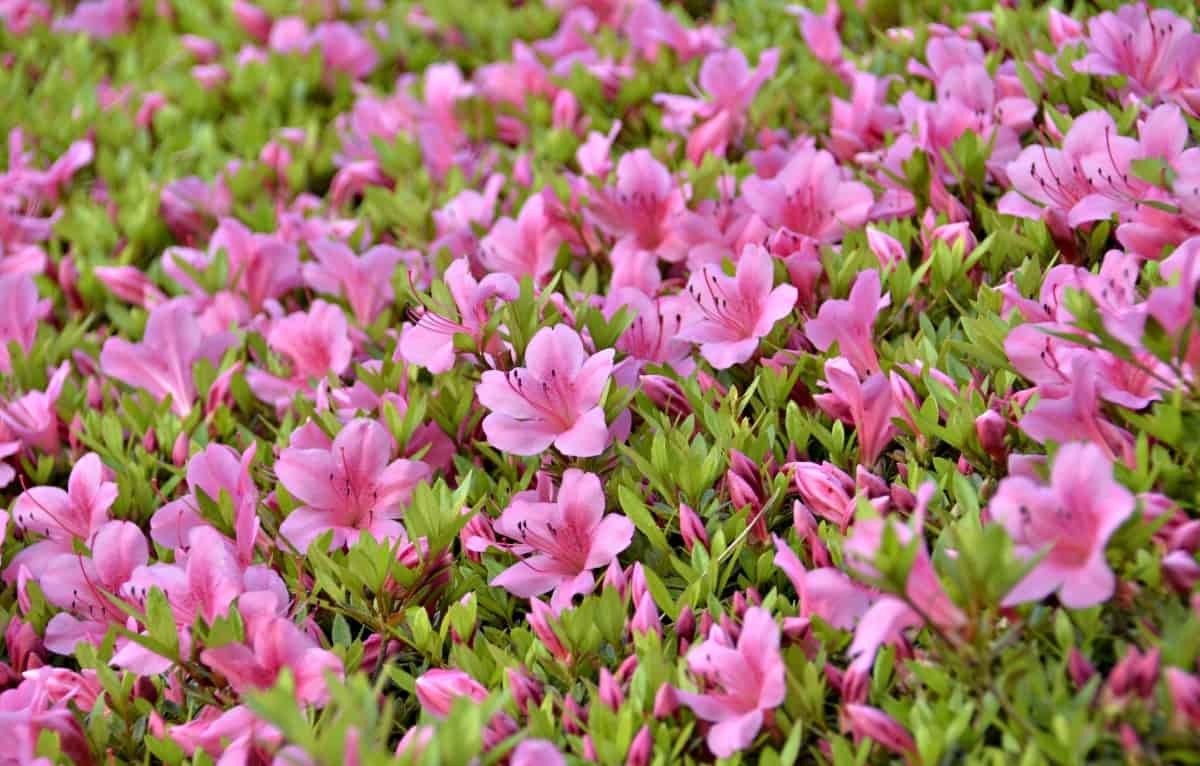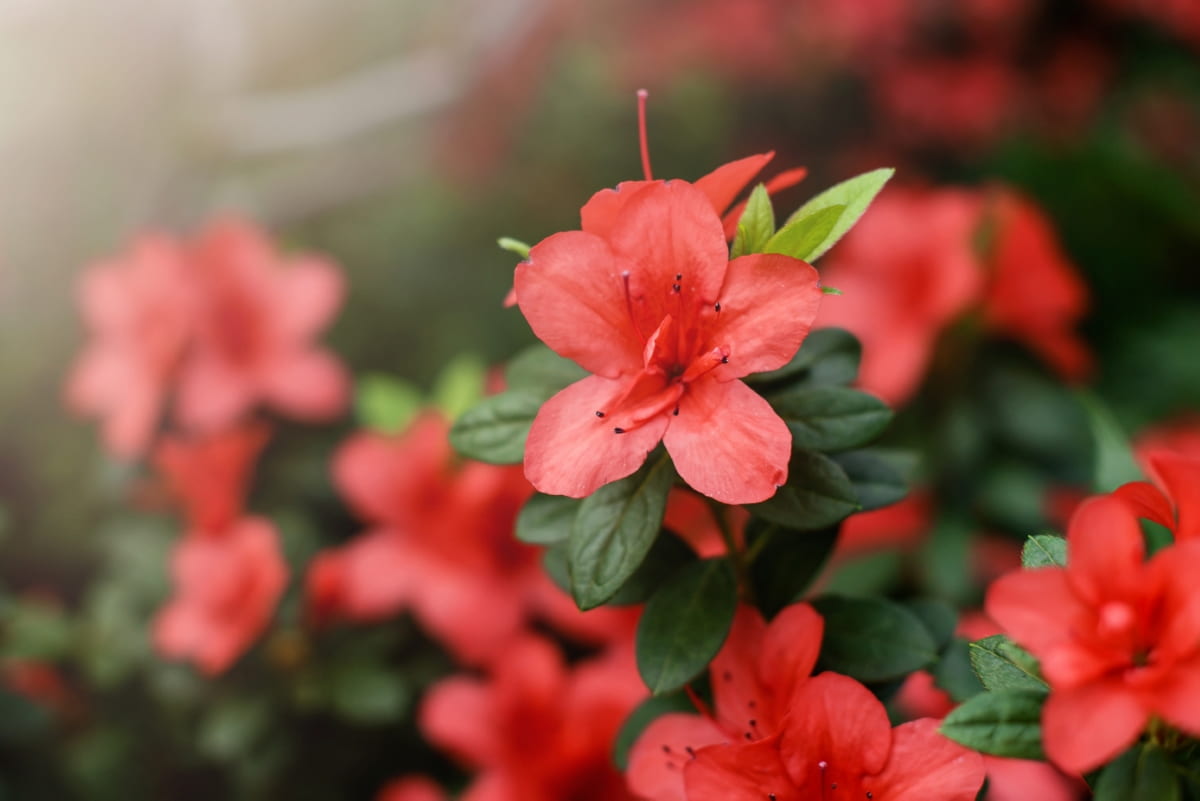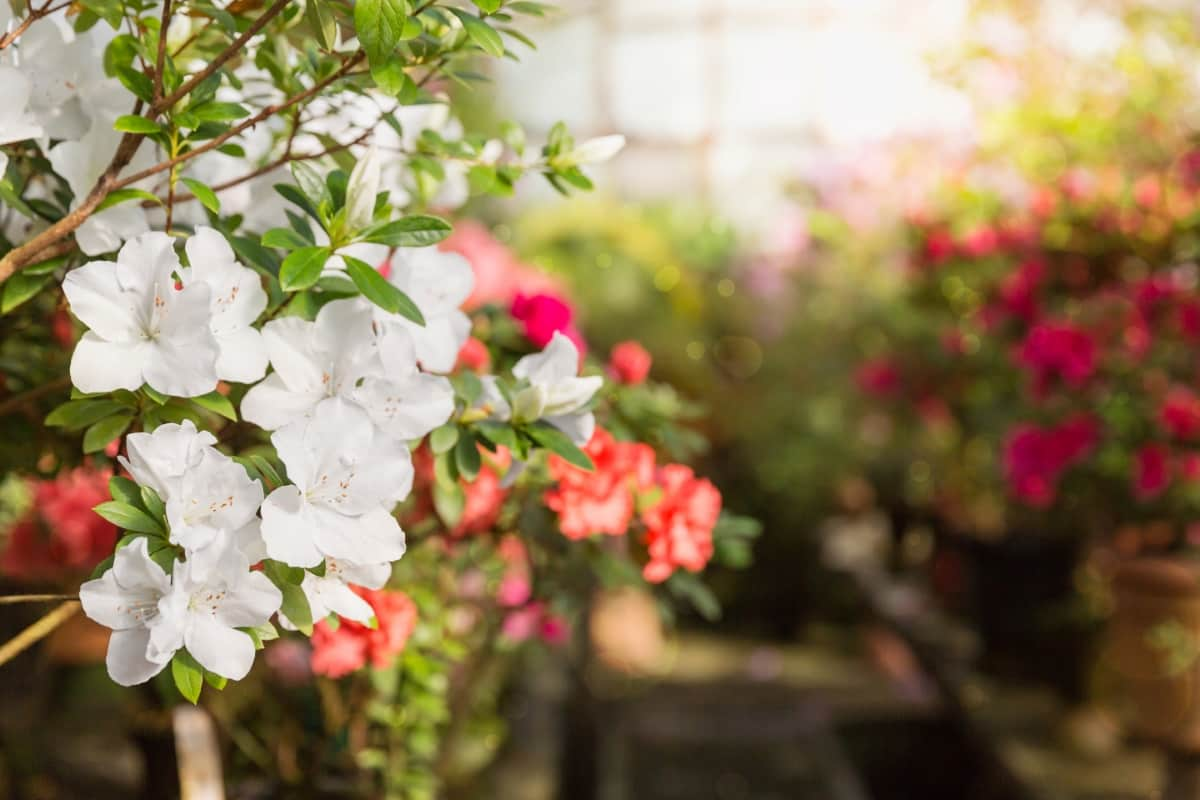Welcome to “The Complete Azalea Guide: Mastering the Art of Growing and Caring for Azaleas”. Azaleas have long been cherished in gardens worldwide with their vibrant and captivating blooms. If you’ve ever wanted to grow beautiful azaleas but weren’t sure where to start, this detailed guide is for you. This blog will demystify growing and caring for azaleas, providing easy-to-follow steps and expert advice. From understanding different azalea varieties to tackling common issues, we’ve got you covered.

Growing and Caring for Azaleas
What is Azalea Farming?
Azalea farming involves cultivating shade-loving evergreen or deciduous shrubs known for their exquisite flowers. These shrubs, adorned with elliptical leaves, add a vibrant touch to spring gardens, showcasing a splendid range of colors such as white, purple, yellow, and red blooms. To ensure successful azalea farming, creating the right conditions is crucial.
Azaleas thrive with at least four hours of daily sunlight but benefit from afternoon shade, especially in regions with scorching summers. Maintaining moist, acidic, and fertile soil supports their growth. Planting azalea shrubs in spring or early fall is recommended, as their growth rates vary, taking several years to reach their full size. It’s worth noting that azaleas are toxic to both humans and pets.
How to Grow Getting Started with Azaleas
When it comes to growing azaleas, there are several important factors to consider for their successful growth.
- Light: Azaleas prefer to grow in partial shade, although they can tolerate full sun. Planting in full sun results in more compact plants with more flowers, but the flowers may not last long. Partial to full shade will produce leggier plants with longer-lasting flowers.
- Water: Azaleas have shallow roots and benefit from regular watering to the plant. Supplementing with additional watering if needed. Drooping leaves indicate the need for water. Slow and deep watering should revive the plant.
- Soil: Azaleas thrive in well-drained soil with a pH of 5.5-6. Use moist soil but not overly wet, as azaleas dislike waterlogged conditions.
- Climate and temperature: Azaleas grow well in hardiness zones 5-9, but check the specific variety for suitability. Southern climates require more shade for azaleas compared to northern climates. Ensure proper wind protection and good air circulation to prevent fungal diseases.
Planting Your Azaleas
- Determine if azaleas are suitable for your climate. Azaleas typically thrive in Zone 6 regions, where temperatures rarely drop below 0 or -10ºF (-17.8 to -23.3ºC). Some deciduous azalea types, like the Roseshell azalea, can withstand Zone 4 temperatures as low as -30ºF (-34.4ºC).
- Optimal planting times are late spring or early fall. Most azaleas will bloom in the following spring when planted during these seasons. However, certain varieties like ‘Weston’s Lemon Drop’ and ‘Flame Creeper bloom in June or July. Another late bloomer, ‘Sweet September,’ displays vibrant pink flowers in September.
- Ensure your soil is suitable. Azaleas thrive in organically enriched, acidic soil with a pH range of 5.5 to 6.0. Avoid heavy clay soil as it can suffocate the roots. If you have alkaline soil, consider building raised flower beds using a mix of coarse sphagnum peat moss and finely milled bark.
- Choose a partially shaded spot. Azaleas generally prefer locations with partial shade, such as areas under tall trees that provide filtered light. However, specific azalea species may bloom better in brighter light. When purchasing azaleas, inquire about the light requirements for your particular species or conduct an internet search for more information. East and north-facing sides of houses are ideal spots due to less direct sunlight.
- Dig a hole that is root ball-sized and twice as wide. When planting, leave the root ball slightly exposed. Space the azaleas 2 to 6 feet apart. Fill the hole halfway with soil, water the planted azaleas thoroughly, and add more soil.
- Apply mulch around the base of your azaleas. Since azaleas have shallow roots, mulching helps retain moisture. Use pine needles, oak leaf mold, or aged hemlock, oak, or pine sawdust as mulch to maintain soil moisture and acidity. This natural mulch provides essential nutrients, reducing the need for additional fertilizer.
Types of Azaleas
- Delaware valley white: An evergreen azalea with snow-white flowers. This variety grows two to four feet tall and three to five feet wide. Hardy in zones 6-9 thrives in partial sun to partial shade. Ideal as a hedge along a fence or porch.
- Electric lights double pink: Known for its magnificent double pink flowers, this larger azalea reaches six to seven feet. It has full sun to partial shade and thrives in zones 4-7. Makes a stunning focal point or a tall hedge. Fragrant and visually appealing.
- Fireball: This deciduous azalea blooms with fiery orange flowers that coincide with leafing out, creating a unique spring display. It is 4 to 5 ft tall and thrives in zones 5-8. Plant in full to partial sun and pair with other spring-blooming or evergreen plants.
- Gibraltar: Offering gorgeous trusses of orange flowers, this variety prefers partial sunlight. It grows five to six feet tall and suits partial or filtered sunlight.
- Lemon lights: This lovely variety produces fragrant yellow flowers, adding brightness to your garden. In zones 4-8, Hardy grows four to five feet tall. Plant in full sun to partial shade. Makes an excellent backdrop for perennial gardens.
Propagating Azaleas
Azaleas can be propagated through stem cuttings or layering, albeit slowly. Stem cutting is a simpler method for most gardeners. Cut five-inch flexible tips from new stems in late spring, remove most leaves, scrape the bark from the bottom inch, dip in rooting hormone, and plant in a well-draining rooting medium. Place the container in a bright, non-direct sunlight location, and roots should develop within four to eight weeks.
For advanced gardeners, layering is an option. In late spring or early summer, bend a flexible branch into a trench, pin it down, and wait for roots to form. Once rooted, separate and transplant the new shoot. Growing azaleas from seeds is possible but time-consuming, taking two to three years to flower. Collect and dry seed pods, sow the tiny seeds of sand and peat moss or seed-starter mix, and keep them in a warm, bright spot. Transplant the seedlings when they have two sets of true leaves, and after a full growing season, repot or transplant them in the ground.
In case you missed it: Rose Contract Farming in India: Profits, Varieties, and Guidelines

Common Pests and Plant Diseases
Depending on the species and region, azaleas can be vulnerable to various pests and diseases. Insects such as aphids, borers, lace bugs, mites, and diseases like canker, leaf spot, and powdery mildew, can affect azaleas. Using horticultural oil, like neem oil, can help control these pests, or beneficial predatory insects may naturally regulate them. However, serious root rot fungal diseases, like Phytophthora root rot, can cause wilting, dieback, and even death. To avoid this, choose resistant cultivars or consider different shrub options. Adequate sunlight, proper feeding, prevention of root-bound plants, and careful deadheading are key to encouraging azaleas to bloom and thrive.
Azalea Care and Maintenance
- Until your azaleas are well-established, they will need regular watering. For these plants to properly absorb water, the soil around their roots and leaves must be damp. When leaves are watered first thing in the morning, they have the day to dry off and prevent mold from forming.
- Water your azaleas during the dry season. Established azaleas can handle themselves, but they may wilt when slightly dry. Monitor your plant and water it when it shows signs of thirst. Using overhead sprinklers in the morning is a suitable watering method.
- Mulch and fertilize after the blooms fade. When the flowers fade in late spring, apply new mulch and use an acid-forming, controlled-release fertilizer to boost the plant’s nutrition. Avoid fertilizing before blooming to promote flower growth rather than leafy growth. Keep the mulch away from the trunk.
- Prune your azaleas when necessary. Pruning deciduous azaleas should be done when they are leafless and dormant. Evergreen azaleas may require pruning to maintain symmetry. Avoid pruning after July 1st to ensure optimal blooms in the following spring. Only prune if necessary, as avoiding pruning is preferable.
Encouraging Azalea Blooms
- Provide partial shade: Azaleas prefer four hours of sunlight daily but benefit from afternoon shade, especially in hot regions.
- Maintain moist soil: Keep the soil consistently moist, but avoid waterlogging.
- Ensure acidic soil: Azaleas thrive in acidic soil with a pH of 4.5 to 6.
- Fertilize appropriately: Use a balanced, acid-loving fertilizer to promote healthy growth and blooms.
- Prune after flowering: Prune azaleas right after they bloom to shape and rejuvenate the shrubs.
- Protect from extreme cold: Spread mulch over a plant’s base to insulate its roots from the cold.
- Avoid over-fertilization: Excessive fertilization can lead to excessive foliage growth at the expense of blooms.
Caring for an Indoor Azalea
- Soil: Use well-drained, acidic soil for potted azaleas. A peat-based potting mix without lime is ideal.
- Fertilization: Feed your plant every two weeks during the growing season with a high-potassium fertilizer designed for acid-loving plants. Look for a fertilizer that contains iron, if possible. Yellow leaves with green veins indicate a nutrient deficiency.
- Light: Place your azalea in a bright room away from direct sunlight. Excessive sunlight can cause browning and leaf damage. Confirm the light requirements of your specific azalea variety.
- Temperature and humidity: Maintain cool to normal room temperatures (60-70°F or 16-21°C) for your azalea. Consider using a humidifier or placing the pot on a wet pebbled tray to provide adequate humidity.
- Encourage reblooming: Help your azalea rebloom by mimicking winter conditions. During fall or winter, expose the plant to temperatures around 40-55°F (4-13°C) for a period of time.
- Pruning: Prune your indoor azalea after it finishes flowering. Use sharp pruning scissors to make clean cuts at a 45° angle, about ¼ inch above a leaf or branch attachment point (leaf node). This promotes more abundant blooms in the future.
In case you missed it: The Best Fertilizer for Lotus: When and How to Apply

Conclusion
Mastering the art of growing and caring for azaleas is a rewarding endeavor. By providing the right conditions, such as well-drained acidic soil, partial shade, and proper watering, you can enjoy the stunning blooms of these exquisite shrubs, creating a vibrant and beautiful addition to your garden.
- Feed Your Flock for Less: Top 10 Tips to Save on Chicken Feed
- Ultimate Guide to Ossabaw Island Hog: Breeding, Raising, Diet, and Care
- Hatching Answers: The Top 10 Reasons Your Chickens Aren’t Laying Eggs
- Eggs and Economics: Breaking Down the Cost of Raising Backyard Chickens
- Defend Your Greens: Proven Methods to Keep Iguanas Out of Your Garden
- Ultimate Guide to Cinnamon Queen Chicken: A Comprehensive Guide for Beginners
- Ultimate Guide to California Tan Chicken: Breeding, Raising, Diet, Egg-Production and Care
- Ultimate Guide to Marsh Daisy Chicken: Breeding, Raising, Diet, and Care
- 10 Types of Chicken Farming Businesses You Can Start for Profits